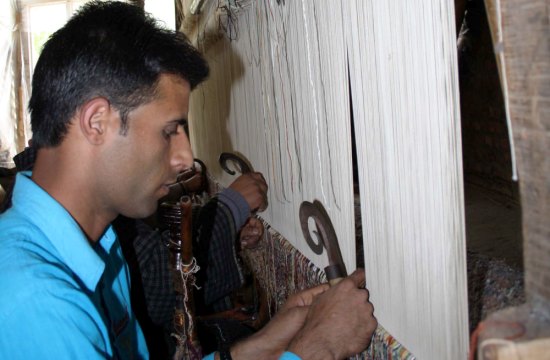It was a blessing and a disgrace at the same time as the apparent insulation of J&K’s small economy from the larger mainland market helped it to tide over many a small shocks. But the global meltdown has crossed the porous silver line and the impact could be devastating if not taken seriously, finds R S GULL.

Unlike Mumbai, no hordes of brightly uniformed bedecked young women are seen protesting over their pink slips in Srinagar. But over the last few months, hundreds have lost jobs and many more are waiting for the last instalments of the wages they earn as weavers, dyers, dryers and cleaners.
White man’s liquidity crunch has triggered a crisis in Kashmir’s disorganised export sector that incidentally is around Rs 1200 crores strong. “Many tiny units in the cottage sector have closed down and many more are expecting in coming days,” says Naseer Ahmad Shah, a handicraft exporter.
J&K’s export basket mainly contains handicrafts. In the last financial year, officials say, the handicraft exports stood at Rs 887 crores with hand-made carpets making the most. The carpets, a Kashmir speciality, have a small high-end market mostly in the West and the Middle East.
Shah says he is frustrated. “All the exporters have their capital blocked as there are no sales,” he said. “Whoever is buying handicrafts chooses the low-cost that Kashmir does not make.”
With dried up sales, the currency cycle has taken a hit. “We have no money to pay the suppliers and they are unable to pay the artisans as a result of which a lot of people are thinking of switching over to other trades to keep their hearths burning,” says Shah. This, Shah says, is a adding to the crisis. “We are already face to face with the problem of artisans’ families opting for non-handicraft trades. If the global meltdown forces the artisans to leave handicrafts we may lose a huge craft that over the ages has emerged part of our identity.”
A globetrotter, Shah is busy meeting artisans and policymakers to manage a way out. Before the global recession could hit the handicraft sector, terror attacks in Mumbai had already dented carpet industry as foreign arrivals dwindled. Though handicrafts are totally dependent on exports, it provides livelihood to tens of thousands of people within Srinagar and its peripheries. Around 350 thousand people, mostly artisans, are engaged in this sector in Kashmir, of which carpets alone employs 150,000 in 30,000 registered looms. The export basket has a bit of horticulture as well. Almonds, walnuts, saffron from Kashmir and apricots from Kargil are the chief export items. Interestingly, all these items are witnessing a fall in foreign earnings even though the quantum of exports has increased.
“For an export volume of 31436 metric tones in 2006-07 our earnings were Rs. 155.52 crores. But in 2007-08 when the volume went up to 44606 metric tones the earnings were only Rs. 77.38 crores,” an official in Horticulture department said. The trend had started well before the slowdown crept in. From Rs. 122.54 crores in 2004-05, the agricultural exports touched Rs. 156.55 crores in 2005-06 only to dip to Rs. 155.52 crores in 2006-07 and to an all time low of Rs. 77.38 crores in 2007-08, according the state’s Horticulture Planning and Marketing department’s outpost in Delhi. (See details on Index page)
The government is yet to collate the export data for the current financial year but the trend is not encouraging. Walnut is hit hard. EU that was consuming almost two-third of walnut from Kashmir reports a demand of barely 10 percent now. Reason: USA, world’s largest walnut producer, hit by recession in its domestic markets has exported nuts to EU countries at one-third of the price. This has dried up the demand for Kashmir exports. Saffron is the only commodity that is better placed this year. It is because of crop failure in Iran, the major Saffron producer, and a low yield back home.
Traders however say the horticulture sector will sail through despite its problems as in items like walnut the demand is consistent though prices are not as encouraging in the domestic market. “The real crisis is in handicrafts”, says Dr Mubin Shah, president Kashmir Chamber of Commerce and Industry (KCCI).
KCCI has met almost all the policy makers in the state to find a way pout, but the responses are not encouraging. So far J&K Bank has acknowledged the problem probably because it has most of its investments within the state and stabilising the economy will help it to sustain its growth story. “We are aware of the problem,” Tafazul Hussain, a top executives of the bank said. “We are working on a livelihood product that will help artisans to sustain the crisis triggered by the meltdown”.













